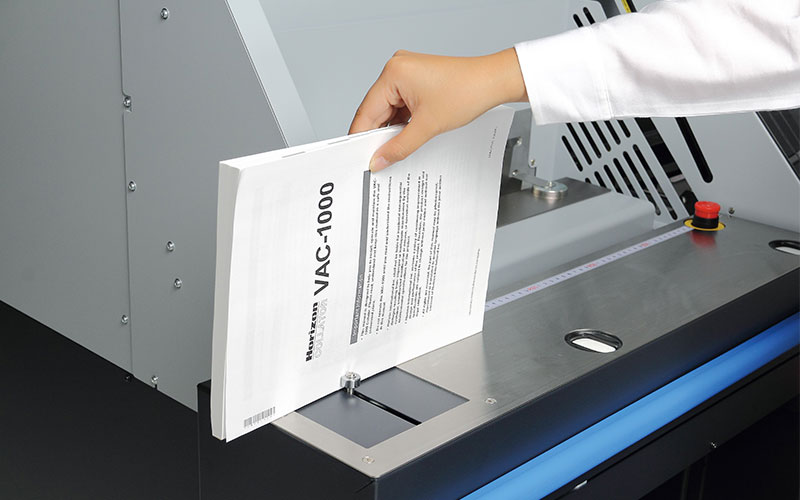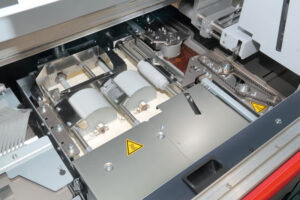
PostPress
When it comes to investing in new equipment, it is always crucial to do a lot of research and ask the right questions before purchasing. No matter the industry, no matter the equipment, it is better to be overly diligent rather than risk possible setbacks and loss of product or profit. To that end, PostPress recently sat down with Bob Flinn, director of business development for Standard Finishing Systems, to discuss what operators should know and look for when it comes to purchasing new perfect binding equipment.
What questions should binders ask when selecting a new perfect binder?
Some binders are designed for high-volume production environments while others are better suited to small- and medium-sized shops. Whether the binder has a continuous print engine or a cut-sheet print engine, the type of perfect binder needed will be dependent on several factors, including: the type of work being produced, the number of print engines, the production environment, the speed of the print engine, the turn time for each job, job volume, overall workflow and run lengths.
With this information, operators will have a better idea of whether a single-clamp or a multi-clamp (high-speed) binder is the best fit. For example, in the case of high-volume applications with limited variability, a multi-clamp binder may be the best fit. However, for high-volume short runs or book-of-one production, it may be more efficient to have two single-clamp binders rather than one multi-clamp binder. When evaluating perfect binding solutions, buyers should make sure to discuss their print environment and needs with their sales consultant.
Are there specific features to look for when working with digitally printed materials?
Those working with digitally printed materials should look for perfect binders that have been designed for this new era of digital print and book-of-one production. Older generations of perfect binders do not come equipped with the level of automation needed to keep up in digital print environments.
The rise of digital print production has coincided with the continued increase in demand for personalization and customization in courseware, photobooks, on-demand novels and more. This has shortened run lengths and increased the level of variability from job to job. Without automation, shops can run into massive bottlenecks in the finishing process because of the increased number of changeovers required to produce this type of work.
If already in a digital print production environment or if there are plans to move in that direction, companies should look for perfect binders with automated, on-the-fly set-up via barcodes and/or calipers to meet the increase in book-of-one and short-run book production.
Which paper stocks work best for perfect binding? What stocks are best to avoid?
 Choosing the right substrate for perfect binding depends on a number of factors, such as the type of perfect binder purchased, usage and stylistic concerns, as well as simple best practices. For example, there are several perfect binding methods, such as EVA (hot melt) binding, PUR (polyurethane-reactive) binding, notch binding and sewn softcover binding.
Choosing the right substrate for perfect binding depends on a number of factors, such as the type of perfect binder purchased, usage and stylistic concerns, as well as simple best practices. For example, there are several perfect binding methods, such as EVA (hot melt) binding, PUR (polyurethane-reactive) binding, notch binding and sewn softcover binding.
If the binder is using EVA binding, it will perform quite well with non-coated stocks, such as bond, vellums, text and book stocks. Coated stocks and printed pages that have printing or coatings running into the gutter will result in a good-looking product, but the binding strength of EVA with these stocks will not meet industry standards.
If the binder is looking to do PUR binding, the range of stocks that will yield good results includes coated papers, heavier weight substrates, photo paper and even some synthetic materials that can be seen in field manuals and medical applications. PUR lends itself to a strong, flexible and lasting bind even with stocks which are “closed” or yield less paper fiber to which the glue can adhere.
Sewn softcover binding is the combination of machine-sewn signatures and hot melt binding. This method will produce a long-lasting binding with coated or non-coated papers. However, it typically does cost more and takes more time to produce than other methods. Additionally, the need for folded signatures means that this method is not well suited for many digitally printed products.
Finally, much like sewn softcover, notch binding uses a special notching process during the signature folding, in combination with EVA binding, to improve the binding strength of a softcover book. This is not a common method in today’s market, but it does produce a stronger bind for EVA adhesive even when using coated stocks.
How can operators cut down on rejects and waste in the binding process?
Today, automation is the key to reducing waste and rejects. The latest generation of perfect binders come equipped with barcode readers and inline integrity solutions that can perform sheet, signature and book-block-level tracking, as well as cover-to-book-block matching.
Depending upon the configuration, these systems can reject incomplete book blocks or book blocks with the pages out of order, catching and removing errors before they become a problem. To go even further, the rejected book then can be identified via barcode and used to generate a reprint file – all without operator intervention.
Or, if there is a situation involving a mismatched cover and book block, automated binders can alert the operator for correction or ejection. Automated inspection systems like this are integral to reducing waste in the perfect binding process.
Some in the industry still are wary of automation. The first generation of automated machines had steep learning curves and raised questions about quality and integrity. Luckily, those days are long gone. Automation today is much more user friendly, more accurate and extremely reliable.
Furthermore, it already is an essential component of every other production process, from order entry to pre-press to printing. At this point, it is essential to have automation in finishing to keep pace. In the case of continuous print, this is of even greater importance. Higher production speeds mean that recovery from an error and/or downtime can be more costly compared to cut-sheet.
PostPress would like to thank Standard Finishing Systems for its assistance with this article. For more details on the company’s perfect binding and other finishing equipment, visit www.standardfinishing.com.

